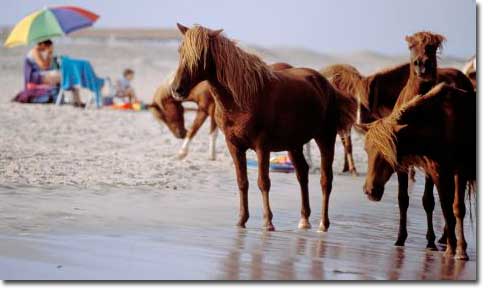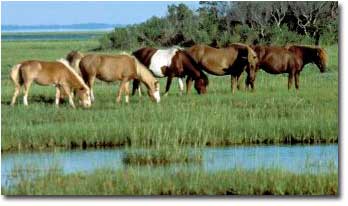 The Peculiar Ponies of Assateague State Park
The Peculiar Ponies of Assateague State Park
By Claudia Padilla
 Named consistently as one of Maryland’s most visited recreational areas, Assateague State Park averages well over one million guests annually. This barrier island park, located on the Atlantic Ocean, is known nationally for the wild horses that freely roam its 850 acres of beach, sand dune, salt marsh and maritime forest.
Named consistently as one of Maryland’s most visited recreational areas, Assateague State Park averages well over one million guests annually. This barrier island park, located on the Atlantic Ocean, is known nationally for the wild horses that freely roam its 850 acres of beach, sand dune, salt marsh and maritime forest.
The wild horses, popularized by Marguerite Henry’s children’s book “Misty of Chincoteague,” have occupied the island for approximately 350 years. Several colorful stories provide possible explanations to their origins. One legend tells of a Spanish galleon running aground along the coast in the 17th century, freeing the horses; a second suggests pirates may have abandoned them. The most logical theory traces the horses back to the early 1600s when settlers used the animals to round up cattle grazing on the island. Over the years, these formerly domesticated horses became wild, having been forgotten or left behind by their owners.
In 1968, Assateague Island National Seashore (AINS), located adjacent to the state park, acquired its original “token herd” of 28 horses through donations from descendants of the area’s early settlers. Today the state park assists the National Park Service in managing the Maryland herd of 155 horses. The parks provide neither veterinary care nor supplemental feeding; because no natural predators exist on the island. The only intentional contact is to administer birth control to handle herd size. (Each mare is allowed to breed once, after which they are injected with an anti-fertilization drug that prevents them from conceiving again.)
 Carl Zimmerman, chief of resource management at AINS, says the horses aren’t particularly unique, of no unusual breed or origin. They are often referred to as ponies due to their small stature although the animals are genetically horses, more specifically related to standard breeds and quarter horses. After years of living in the a photo of ponies on Assateague.harsh barrier island environment, they have adapted by maintaining shorter, stockier builds that allow them to better navigate the unstable grounds of a marsh. Thick winter coats help protect them from strong ocean winds and from the many insects found on the island. Zimmerman finds their intrigue is their feisty ability to remain wild, despite the millions of summer vacationers entering their habitat.
Carl Zimmerman, chief of resource management at AINS, says the horses aren’t particularly unique, of no unusual breed or origin. They are often referred to as ponies due to their small stature although the animals are genetically horses, more specifically related to standard breeds and quarter horses. After years of living in the a photo of ponies on Assateague.harsh barrier island environment, they have adapted by maintaining shorter, stockier builds that allow them to better navigate the unstable grounds of a marsh. Thick winter coats help protect them from strong ocean winds and from the many insects found on the island. Zimmerman finds their intrigue is their feisty ability to remain wild, despite the millions of summer vacationers entering their habitat.
This constant interaction with the public has threatened the wildness of the horses and often results in accidents. Regular incidents include vehicles colliding with horses and visitors venturing too close getting kicked or bitten. The park staff encourages guests to enjoy the horses from a safe distance, but prohibits physical contact, feeding and/or teasing of the animals.
Since they feed on cordgrass, greenbrier and even poison ivy, the salt marsh of the Sinepuxent Bay is the best place to see the horses. Freshwater ponds and beach grasses are integral parts of their diets as well.
Assateague State Park Manager Mike Riley says that the horses are a definite attraction, second only to the park’s main draw – its idyllic oceanfront location. While its amenities include 350 camping sites, bike trails, a marina, multiple fishing and picnicking areas, wildlife viewing and nature programs, for many summer visitors it is simply the perfect place to spend the day relaxing, sunbathing and swimming.
Claudia Padilla has worked at Assateague State Park as a member of the Maryland Conservation Corps and on the Lower Eastern Shore under Americorps conducting environmental education programs. Her service concluded, she is currently seeking a career in the field of environmental communications.
Note: This article originally appeared in the Fall 2005 issue of the The Maryland Natural Resource magazine.